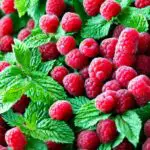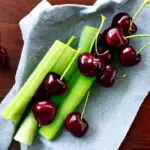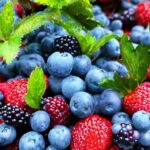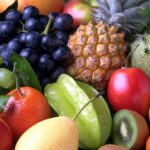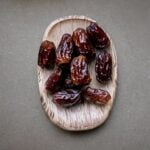
There are many fruits and vegetables in the world, and all of them are great foods for you to eat to better your health!
In this post, we will look at fruits and vegetables that start with the letter “B”. First, we will start with fruits, giving descriptions for each one. Then we will look at the vegetables. (For just the fruits, you can see Fruits that Start with B. And for just the vegetables, you can visit Vegetables that Start with B)
Contents
- Fruits that Start with B
- Banana
- Blueberry
- Blackberry
- Bilberry
- Boysenberry
- Bayberry
- Bael Fruit
- Barbados Cherry
- Balsam Apple
- Bearberry
- Barberry
- Buffaloberry
- Black Cherry
- Blue Plum
- Black Mulberry
- Black Raspberry
- Blood Orange
- Black currant
- Babaco
- Bilimbi
- Bitter Melon
- Black Sapote
- Bottle Gourd
- Breadfruit
- Burmese Grape
- Bacupari
- Brazilian Guava
- Blood Lime
- Black Diamond Apple
- Vegetables that Start with B
- Fruits and Vegetables Lists
Fruits that Start with B
There are many fruits that start with B. Some of the most common are bananas, blueberries, and blackberries. But there are many more as well.
Banana
The banana is a fruit and probably the most well-known fruit on this list. In fact, the banana is the most popular fruit in the world. You can find the banana in almost every grocery store in America and even sometimes in gas stations.
Bananas are good to eat every day since they have good nutrients and antioxidants. Bananas are not shown to cause weight gain and actually might help with weight loss due to the fiber they provide.
Blueberry
Blueberries are tiny round blue fruits with tons of health benefits. They are packed with tons of antioxidants which give them their nice blue color. Furthermore, they have a good amount of Vitamin C.
Blueberries are good for blood pressure, heart health, brain health, skin health, cancer prevention, and more. Blueberries are also high in fiber and can help with constipation.
Eating blueberries every day can help with the digestive system and help with weight management. 150g of blueberries every day has been shown to reduce the risk of heart disease.
Blackberry
Blackberries are small dark fruits that contain antioxidants and vitamins. They have impressive health benefits and might even help to fight certain cancers.
Blackberries have a lot of manganese. They also have even more vitamin C than blueberries.
Blackberries are also high in fiber which can help gut health and for keeping bowel movements regular.
Bilberry
Bilberries are the European version of blueberries. They look like small blueberries. When compared to blueberries, bilberries are smaller and also darker in color.
Bilberries are good at improving heart health and reducing inflammation, and also help with brain health, much like blueberries do. Like blueberries, bilberries are also high in vitamin C.
Boysenberry
Boysenberry is considered to be a blackberry and looks like a cross between blackberries and raspberries. That’s because it actually is. It’s a cross between both of these fruits as well as loganberry.
Boysenberries are hard to find in stores since they are very fragile and hard to transport and package.
Bayberry
This Asain fruit is also called the Chinese bayberry, Japanese barberry, red bayberry, or Chinese strawberry.
The bayberry fruit is edible either raw or cooked. It’s highly nutritious.
Bayberries usually have a red or purple color. They are round and about 2 cm wide.
They are called Chinese strawberries, and the flavor of Chinese bayberry is almost identical to strawberries.
Bael Fruit
The Bael fruit is found and used in India and Southeast Asia. In English, Bael is also known as golden apple, wood apple, stone apple, Japanese bitter orange or Bengal quince.
Bael is good for digestive health and is used to help with constipation or diarrhea.
Bael fruit is commonly used to make juices. Sometimes the taste is described as a bitter citrusy flavor
Barbados Cherry
Barbados cherry is the same as acerola, which is seen in Fruits that Start with A.
Barbados Cherry is super high in vitamin C. They have some of the highest concentrations of vitamin c of any fruit or plant. The antioxidants also give Barbados cherry its deep red color.
Barbados cherry is edible. The flavor is a little bit sour or tart with the flavor of apple, or like a Star Fruit.
Balsam Apple
Balsam Apple or Momordica balsamina is native to Africa but is now found as an invasive plant all over the world. It’s even said that Thomas Jefferson planted this vine in the early 1800s.
Balsam Apple is also known by the names African cucumber or balsam pear. It is used in a variety of places for its medicinal properties.
The Balsam apple has a very unique and pointy look. Balsam apples are edible. Although there are claims they are poisonous, many eat them without any adverse effects.
Bearberry
Bearberry can be eaten by humans, but it gets its name from the fact that it is a popular berry for bears to eat. They are small red berries that are eaten either cooked or raw.
When eaten raw, there is actually not much flavor.
Below you can view some of Bearberry’s benefits. It’s been used, along with the leaves, for medicinal purposes.
Barberry
Barberries are similar in appearance to goji berries but actually have much higher antioxidant levels.
Barberry is edible and can be eaten raw or used in jams or added to other foods. They are slightly sweet, with a tart flavor.
There are concerns because it is an invasive plant and will overtake other plants in ecosystems. Also, they tend to attract high levels of ticks which contribute to Lyme disease.
Buffaloberry
Buffaloberry is native to North America in the north and west. They are tiny red fruits that are edible and can sometimes be yellow-colored.
They have a strong tart or bitter flavor and can be eaten raw, or cooked into jams or sauces.
Black Cherry
Black cherry is also referred to as mountain black cherry, wild black cherry, or rum cherry.
They can be eaten raw and are sometimes used in beverages, wine, or jelly. Black cherries are not poisonous, but the rest of the plant they come from is.
Black cherry is high in antioxidant levels and has also been used to help with gout.
Blue Plum
The blue plum is also known as the Blue Damson plum.
They have a sour flavor, and because of this are usually used to make jelly.
Black Mulberry
Mulberries look like blackberries but are longer and more oval-shaped. They may have originated in the Middle East, but are growing in use around the world.
Mulberries are great tasting and can be eaten raw. They have a sweet flavor, and can also be dried or made into a jam, wine, juice, or tea.
Mulberries are safe to eat if you find them in the wild, and can be eaten straight off the tree. They are not poisonous, as long as they are ripe. Unripe mulberries can be poisonous, but their toxicity levels are low. Birds are also known to eat mulberries.
Black Raspberry
Black raspberries are found in Eastern North America. They look almost identical to blackberries, but they are not the same as blackberries. You can distinguish the black raspberry from the blackberry, because the black raspberry will have a hollowed center, instead of being solid.
Unlike blackberries though, black raspberries are very rare and hard to find. If you do find some, however, they are good for you and high in vitamin C, and may have anti-cancer benefits.
Blood Orange
Although the name sounds a little strange, the blood orange or red orange, gets its name from its coloring. The blood orange is a version of an orange with a dark red colored inside. It gets this coloring from the anthocyanins present, which are normally not in citrus fruits.
The blood orange was the result of a crossing between a tangerine and a pomelo. The cost is usually a little more than a regular orange, but some find it worth the extra cost.
It has a taste similar to a regular orange, with a slight difference. The blood orange is sweeter and also carries a bit of tartness, much like a grapefruit, but with less of an acidic taste. Some describe a hint of raspberry taste.
Blood oranges are healthy and are high in antioxidants. The blood orange has slightly less vitamin c than a regular orange but still has a good amount at 120 percent of your daily recommended value.
Black currant
The blackcurrant, also called the black currant or cassis, was originally found growing in Central Europe and North Europe, and Asia. It resembles a dark grape but is smaller in size. In appearance, they are very similar to blueberries, but they are very much different fruits beyond their appearance.
Be aware, that some companies sell something called “currants” which are just dried grapes or raisins and are not real black currants.
Black currants have a taste much like a blueberry, or blackberry but are less sweet and are more sour with an herbal overtone.
Black currants have great health benefits and are high in antioxidants and vitamin c. They may also help against cancer and can have immune-boosting benefits.
Black currants are called the forbidden fruit because they were made illegal to grow in the United States in 1911. This was because they carried a fungus called the white pine blister rust disease, which threatens white pine trees.
The federal ban was removed in 1966, but many states still carry the restriction, and because of the long ban, black currants are not popular or well-known in the U.S.
Babaco
The Babaco is a large yellow Ecuadorian fruit, related to papaya. The babaco actually looks very much like a papaya. It is torpedo-shaped and also forms star shapes when cut into.
Babaco can be eaten cooked or raw. It is seedless and sometimes the raw form is mixed into salads or made into dessert fillings. Another option is to use babaco to make drinks or ice cream.
The babaco has a lot of flavor in it and gets many different descriptions of what it tastes like. One describes babaco as tasting like a pineapple mixed with papaya.
Bilimbi
Bilimbi is a crunchy yellow and green colored fruit. They have a very sour taste.
Bilimbi has been used medicinally to treat sore throats, reduce fever, and fight the flu. It’s also used to treat coughs as a cough syrup.
Bitter Melon
Bitter melon is also known as bitter gourd and is grown in Africa, Asia, and the Caribbean.
Bitter melon has some health benefits and is high in some nutrients. It may have ant-cancer benefits, help with weight loss, reduce cholesterol, and improve blood sugar levels.
Black Sapote
The black sapote is a dark brown and soft fruit when ripe. It’s also known as chocolate pudding fruit. Other names are black soapapple and zapote prieto. It’s found in Central America and Mexico.
Black sapote gets its name from actually tasting like chocolate pudding when ripe! It also has a hint of pumpkin flavor and is soft and smooth like custard.
Black sapote is also good for you and is high in vitamin A. However, black sapote is rare and can be hard to find.
Bottle Gourd
Bottle gourd is also known as a calabash. It is a green fruit but is usually eaten as a vegetable.
Breadfruit
Breadfruit is closely related to jackfruit and very similar in appearance. It is also very similar in appearance to the fruit of the Osage orange tree. It can be classified as somewhat of a starchy, carbohydrate fruit. Durian is also closely related to Breadfruit as well.
Breadfruit is a tropical fruit, and it’s found growing in the U.S. in southern Florida and in the Keys or is imported from Jamaica.
Breadfruit gets its name because it tastes very much like bread once cooked. It has a starchy flavor which can be also similar in taste to potatoes.
Breadfruit is considered a superfood and has some good benefits to eating it and it comes packed with nutrients, antioxidants, and lots of fiber and protein. Breadfruit is good for lowering cholesterol, blood pressure, and for helping with diabetes. It also has Omega fatty acids, potassium, magnesium, B vitamins, and carotenoids, and is low in fat.
Breadfruit is so similar to jackfruit, that you can sometimes substitute jackfruit for breadfruit in recipes. Also, since the taste is similar to potatoes, you can also substitute potatoes as well. Breadfruit can be used as a substitute for potatoes as well in dishes.
Burmese Grape
The Burmese grape is found growing on a tree throughout Asia, mainly in rainforests and some monsoon areas, such as Vietnam, Burma, Malaysia, and India. It’s also referred to as Leteku or Lataku.
The flavor of the Burmese grape is slightly sweet and tastes much like a regular grape. Burmese grapes are usually eaten raw after picking or can be made into wine.
Bacupari
The Bacupari is sweet fruit with a yellow or orange color. They are found growing in the Amazon in South America.
Brazilian Guava
Brazilian guava, or guava, is popular in Brazil and other tropical climates in the world. It has a sweet flavor and has a taste like pineapple and papaya.
Blood Lime
The blood lime is a rare fruit that gets its name from its unique red color. It was created as a hybrid fruit between the Australian Finger Lime and a mandarin. Blood limes carry the taste and sourness of a lime, but also with a sweetness to them, like citrus fruit or mandarin.
Black Diamond Apple
The black apple, black diamond apple, or Arkansas black apple is a rare fruit that looks like a very dark-colored apple.
The taste of Black Apple is sweet with almond, vanilla, and honey flavors. Black apples can be eaten raw, and are also used to make juice, cider, vinegar, or pies.
Vegetables that Start with B
Next, we will look at the vegetables. There are several vegetables that start with the letter “B”, each with its own unique taste, texture, and nutritional value. These vegetables include:
Beets
Beets are a root vegetable that has a sweet and earthy taste. They are high in fiber, potassium, and antioxidants.

Beets are also a good source of folate, which is essential for pregnant women and helps to prevent birth defects. They are also known to improve blood flow and lower blood pressure.
Bok choy
Bok choy is a type of Chinese cabbage that has a mild, slightly sweet flavor. It is high in fiber, vitamin C, and antioxidants.
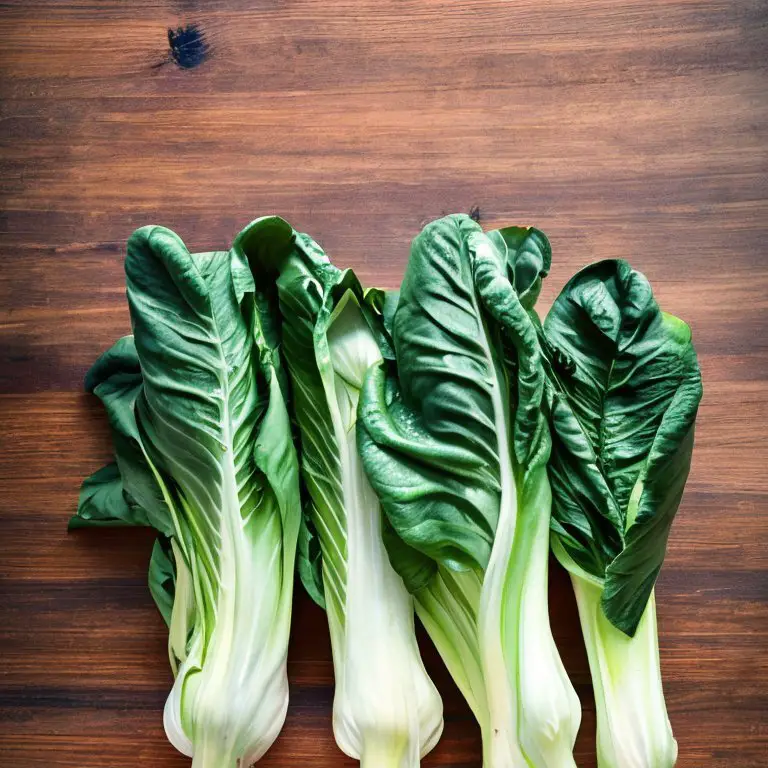
Bok choy is also a good source of vitamin K, which is important for blood clotting and bone health.
Bell peppers
Bell peppers come in a variety of colors including green, red, yellow, and orange. They are known for their sweet, slightly bitter taste and are high in fiber, vitamin C, and antioxidants. Bell peppers are also a good source of vitamin A, which is important for eye health.
Broccoli
Broccoli is a cruciferous vegetable that is known for its strong, slightly bitter taste. It is high in fiber, vitamin C, and antioxidants.

Broccoli is also a good source of vitamin K, which is important for blood clotting and bone health.
Brussels sprouts
Brussels sprouts are small, round vegetables that are known for their slightly bitter taste. They are high in fiber, vitamin C, and antioxidants. Brussels sprouts are also a good source of vitamin K, which is important for blood clotting and bone health.
Butternut Squash
Butternut Squash is a type of winter squash that is a good source of vitamin A, vitamin C, and potassium. It’s also a good source of fiber and has a sweet, nutty flavor. Butternut Squash can be used in a variety of dishes such as soups, stews, and casseroles.
Beet greens
Beet greens are the leafy greens that grow on top of beetroot plants. They are high in vitamins and minerals, and can be eaten cooked or raw in salads. They have a slightly bitter taste.
Butterhead lettuce
Butterhead lettuce is a type of lettuce with a soft, buttery texture and a mild flavor. It is also known as Boston lettuce or Bibb lettuce. It is often used in salads and sandwiches. The leaves are typically large and loose, with a pale, yellow-green color.
Black Beans
Black beans are a type of legume that is native to Central and South America. They are a staple food in many Latin American cuisines and are known for their rich, earthy flavor and creamy texture. They are high in protein and fiber, and are often used in soups, stews, and rice dishes.
Broad Beans
Broad beans, also known as fava beans, are a type of large, flat legume that grows in a pod. They have a mild, nutty flavor and a creamy texture. They are popular in Mediterranean and Middle Eastern cuisines and can be eaten fresh or dried.
Broccoflower
Broccoflower is a hybrid vegetable that is a cross between broccoli and cauliflower. It has a similar appearance to cauliflower, but has a green color. It has a milder taste than broccoli and can be eaten raw or cooked.
Broccoli Rabe
Broccoli Rabe, also known as rapini, is a leafy green vegetable that is related to the turnip. It has small florets and has a bitter, nutty flavor. It is commonly used in Italian and Chinese cuisine and can be sautéed, stir-fried or steamed.
Broccolini
Broccolini is a hybrid vegetable that is a cross between broccoli and Chinese broccoli. It has small florets and long, thin stems, and has a milder, sweeter taste than broccoli. It can be eaten raw or cooked and is a popular vegetable to sauté or stir-fry.
Black radish
Black radish is a type of radish that is known for its dark, black skin and pungent, spicy flavor. It is high in fiber, vitamin C, and antioxidants.
Burdock root
Burdock root is a long, thin root vegetable that is known for its earthy, slightly sweet flavor. It is high in fiber, vitamin C, and antioxidants.
Belgian endive
Belgian endive is a type of chicory that is known for its crisp, slightly bitter flavor. It is high in fiber, vitamin C, and antioxidants.
Black kale
Black kale is a type of kale known for its dark, purple-black leaves and slightly bitter flavor. It is high in fiber, vitamin K, and antioxidants.
Black salsify
Black salsify, also known as Scorzonera, is a root vegetable with a slightly sweet and nutty taste. It is high in fiber and vitamin C.
Fruits and Vegetables Lists
Fruits and Vegetables Lists A-Z
- Fruits and Vegetables that Start with A
- Fruits and Vegetables that Start with B
- Fruits and Vegetables that Start with C
- Fruits and Vegetables that Start with D
- Fruits and Vegetables That Start With E
- Fruits and Vegetables that Start with F
- Fruits and Vegetables that Start with G
- Fruits and Vegetables that Start with I
- Fruits and Vegetables that Start with M
- Fruits and Vegetables that Start with R
- Fruits and Vegetables that Start with X
- Fruits and Vegetables that Start with Y
- Fruits and Vegetables that Start with Z
- Fruits and Vegetables Lists A-Z
Fruits Lists A-Z
- List of Fruits from A-Z (in Alphabetical Order)
- Fruits that Start with A
- Fruits That Start with B
- Fruits that Start with C
- Fruits that Start with D
- Fruits that Start With E
- Fruits that Start with F
- Fruits that Start with G
- Fruits that Start with I
- Fruits that Start with M
- Fruits that Start with R
- Fruits that Start with S
- Fruits that Start with W
- Fruits that Start with X
- Fruits that Start with Y
- Fruits that Start with Z
- 100 Fruit Names (Most Popular Fruits in the World)
- Top 50 Fruits Names List
- Top 20 Fruit Names
- Fruits Lists A-Z
- List of Berries A-Z
- Berries Lists A-Z
Vegetables Lists A-Z
- Vegetables List A-Z in Alphabetical Order
- Vegetables that Start with A
- Vegetables that Start with B
- Vegetables that Start with C
- Vegetables that Start with D
- Vegetables that Start with E
- Vegetables that Start with F
- Vegetables that Start with G
- Vegetables that Start with I
- Vegetables that Start with M
- Vegetables that Start with R
- Vegetables that Start with X
- Vegetables that Start with Y
- Vegetables that Start with Z
- Vegetables Lists A-Z
- 100 Vegetable Names (Most Common in the World)
Lance has been passionate about the plant-based diet and we have been following a whole food plant-based diet for over 5 years. We focus on health, natural healing, weight management, animal rights, and the health of the planet and environment by focusing on whole plant-based foods and sustainable practices.
Learn more at the About Me page and follow on social media at the links below.

